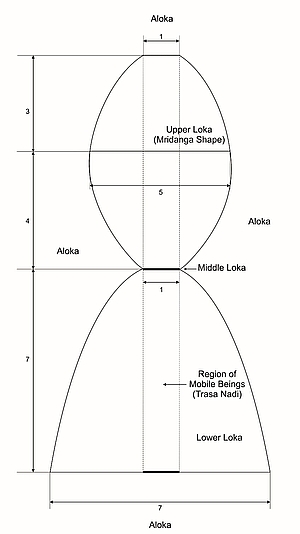The universe in Jainism is the space that contains the six real - Jiva (soul), pudgala, akasa (space), kala (time, kala is the passive agent of change of modes of real), dharmastikaya (passive agent of motion of soul and matter) and adharmastikaya (passive agent for non-motion of soul and matter). "Time" as used in science is equivalent to empirical time (vyavaharakala) in Jainism, which is the means of measuring the duration of time intervals. Empirical time is defined with respect to the movement of some chosen object like the sun or moon and is only applicable to events related to pudgala. Empirical time is not defined for the soul or any other eternal real. For example, akasa (space) is eternal; it did not come into being at any particular instant, as is supposed by the Big Bang Theory. In Jainism the universe is eternal; it was neither created by a supernatural power like God nor by any event like the Big Bang. Akasa is infinite and our universe, the loka, is a tiny spot located in this infinite space. The akasa beyond the universe, called aloka, contains no other real; it is only empty space.
Loka, being finite, has a shape. Bhagwati Sutra 7.3 describes the shape of the loka as trisharavasamputakar, which means that the shape of the loka is obtained by assembling three bowls of nearly truncated conical shape, as shown in Figure 1. The lower loka is an inverted bowl and two bowls placed one above another constitute the upper loka; the lower one is in an upright position and the upper one is inverted and placed over it. The two bowls of the upper loka provide the shape of mridanga, a musical instrument of the drum family. The total height of the loka is 14 rajju; the height of the lower loka and upper loka is 7 rajju each. Rajju is a very large distance measuring billions of light-years. The width at the bottom of the lower loka is slightly less than 7 rajju. The width is 1 rajju at the middle loka, 5 rajju at the brahma loka, and 1 rajju at the top. The cross section of the loka at any height is circular. Some other geometries of the loka have been described in Digambara and Svetambara texts, but these geometries have corners that are unlikely to exist in nature, since all astronomical structures are seen to be nearly circular or spherical, without corners.

Figure 1. Three Bowl-Shaped Loka. Distances are in rajju. The upper two bowls together produce a mridanga (a musical drum) shape. The middle loka at the junction of the lower two bowls is a flat disc of 1 rajju diameter.
Worldly souls, which are impure due to their association with karma, exist in four classes: animals with one to five senses, human beings, infernal beings living in hells, and celestial beings living in heavens. All of these beings fall into two groups, mobile and immobile. Mobile beings can move by themselves and include all four classes of beings. Immobile beings are the lowest class of animals and have only one sense of touch. These beings cannot move by their own effort. Immobile beings are of two types, subtle and gross; subtle beings are invisible to the eye.
The loka is divided into regions according to the class of beings that live in that region. The central region of the loka is called the trasanadi, or mobile zone, the abode of mobile organisms (see Figure 2). The cross-section of the mobile zone is circular with a diameter of 1 rajju. The height of the mobile zone is 14 rajju. All-mobile beings, including celestial and infernal beings, inhabit this zone. This means that mobile beings are found in a region of space of only about 10 cubic rajju out of the total space of 343 cubic rajju of the whole loka. The bottom part of trasanadi of about one cubic rajju contains inexhaustible number of nigoda jiva in passive mode.
 Dr. N.L. Kachhara
Dr. N.L. Kachhara
